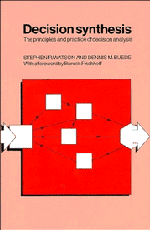2 - RATIONAL DECISION-MAKING
from PART I - THEORY
Published online by Cambridge University Press: 16 September 2009
Summary
THE DIFFICULTIES OF DECISION-MAKING
In some ways we can describe decision-making as the most common human activity. Almost everything we do involves decisions. Whether we are driving a car, preparing a menu for a meal, working out what to say next in a piece of writing, or handling a difficult social situation, to give just a few examples, we have to make choices and decide to adopt one course of action rather than another. Since we are involved in so much decision-making, we might expect that the human species has evolved to be good at it. Viewed in one way this is indeed the case, in that we have developed many innate mechanisms for effective intuitive decision-making in our best interests. As babies, our unconscious decision to cry when hungry, or in pain, surely is the wisest way of improving our lot! As mature adults, our instinct to dodge a stone thrown at us is an intuitive decision that maximizes our welfare. These are at the unconscious level. At the conscious level, however, we have also developed ways of making decisions without much thought. Habits of driving, acting according to conventions of social behavior, following norms of hygiene or diet, all lead to good decision-making.
- Type
- Chapter
- Information
- Decision SynthesisThe Principles and Practice of Decision Analysis, pp. 8 - 17Publisher: Cambridge University PressPrint publication year: 1988



